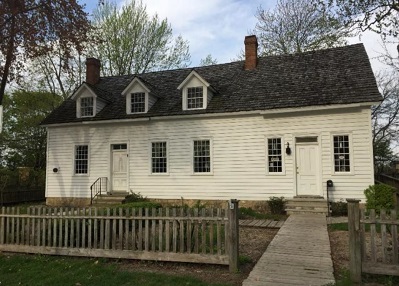Park House National Historic Site of Canada
Amherstburg, Ontario

Park House, front elevation.
© Jennifer Cousineau, Agence Parcs Canada / Parks Canada Agency, 2017.
Address :
214 Dalhousie Street, Amherstburg, Ontario
Recognition Statute:
Historic Sites and Monuments Act (R.S.C., 1985, c. H-4)
Designation Date:
2018-07-31
Dates:
-
1790 to 1796
(Construction)
Other Name(s):
-
Park House
(Designation Name)
-
Park House Museum
(Other Name)
Research Report Number:
2017-11; 2017-30
Plaque(s)
This 18th-century house is a rare example of a once-common building type, with its French-framed poteaux-en-coulisse (grooved post) construction, asymmetrical design, and centre-passage plan. Its original waterfront location in a transborder region of southwestern Ontario made this combined home and warehouse a strategic base for traders and merchants, including the Park brothers. This house, owned for many years by the Park family, is thought to have been floated down the Detroit River to Upper Canada by Loyalists after Britain ceded Detroit in 1796. The house was moved again in 1972 and converted to a museum on this site.
Description of Historic Place
Park House National Historic Site of Canada is an attractive one-and-a-half storey house of “French framed” construction, typical of 18th century French Canadian dwellings in the Detroit River region. Its structural system uses the pièce-sur-pièce method in its poteaux-en-coulisse (grooved post) variation, covered by horizontal weatherboard. The house has a steeply-pitched side-gable roof animated front and rear by three gabled dormer windows. It is longer than it is wide, due to an addition made in the 19th century of office space for Dr. Theodore Park. The front elevation, faces Amherstburg’s main street and has two entrances. The office side of the house has a simple roof pitch with no windows. The original dimensions of the 18th century house are delineated at the ridgeline by two substantial red-brick chimneys. Official recognition refers to the building on its footprint.
Heritage Value
Park House was designated a National Historic Site of Canada in 2018. It is recognized because: it is a rare example of a once-common colonial building type found in settlements and fur-trading posts across colonial North America. Its asymmetrical design, center-passage plan and French-framed grooved post construction are rooted in a common French-Canadian vernacular architectural language; one of the oldest houses in the region, the Park House has a long association with fluctuations in the economic history of the transborder region in Southern Ontario. Its early use by transplanted Detroiters and transformation by the Park Brothers in the context of the local shipping industry attest to the history of settlement around Windsor, where colonial power struggles were manifest not only in fluctuating borders but also in the architecture and landscapes of the region; it has long been contended that this combined dwelling and warehouse was floated down the Detroit River to Upper Canada by its Loyalist owners when Detroit was handed over to the Americans by the British in 1796.
When the Park House was threatened with demolition in the early 1970s, concerned citizens, led by Hazen Price, purchased it, move it to a new site on the same street, and transformed it into a community museum. An active group of volunteer tinsmiths works in the basement shop to produce goods for sale in the museum. Such activities provide an opportunity to illuminate the history of Amherstburg in the context of the Detroit River region.
Source: Historic Sites and Monuments Board of Canada, Minutes, December 2017.
Character-Defining Elements
Key elements contributing to the heritage value of this site include: the generous setback from Dalhousie Street, on a large waterfront lot; its location in the downtown neighbourhood of Amherstburg, the oldest outside of Fort Malden; pièce-sur-pièce, poteaux-en-coulisse construction; small scale, 1.5 storey height; steeply pitched, side-gable roof profile; addition of Theodore Park’s doctor’s office on the south side of the house that renders the former center-hall plan asymmetrical; three gabled dormers at the front and three at the back; two front entrances: the original entrance and Theodore Park’s office entrance, corresponding to two rear entrances; two substantial red-brick chimneys at the ridgeline delineating the original dimensions of the 18th century house; centre-passage plan of the original dwelling, with two rooms at the front, and two at the back; the division of the plan into formal front rooms and rear work rooms; exposed wall section showing timber framing and marriage marks; kitchen addition with large open hearth and storage room; Unobstructed view to the Detroit River at the rear of the house.